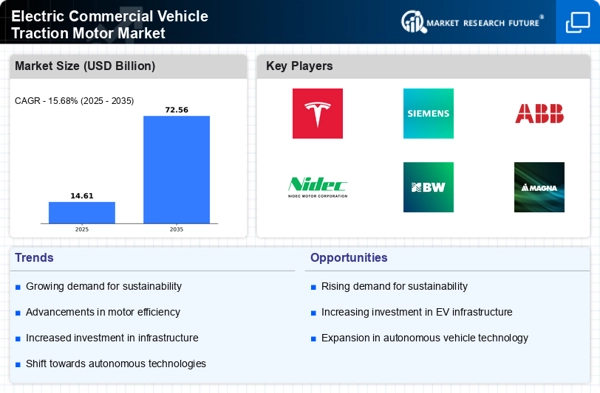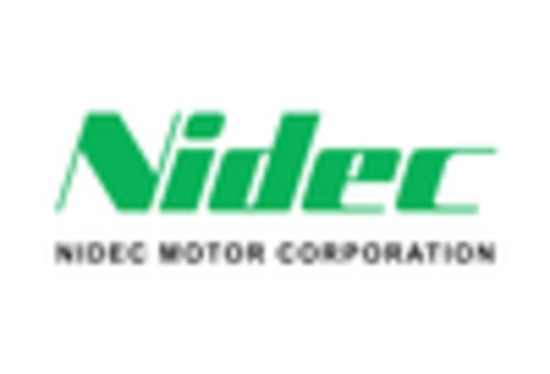Advancements in Battery Technology
The Electric Commercial Vehicle Traction Motor Market is poised for growth due to advancements in battery technology. The development of high-capacity, fast-charging batteries has significantly improved the performance and range of electric commercial vehicles. This enhancement is crucial, as it directly influences the efficiency of traction motors, which rely on battery power for operation. Recent studies indicate that the integration of next-generation battery systems can increase the operational range of electric vehicles by up to 30%. As battery technology continues to evolve, it is likely to further stimulate the demand for electric commercial vehicles, thereby positively impacting the traction motor market. Manufacturers are thus focusing on creating motors that can effectively utilize these advanced battery systems, ensuring optimal performance.
Increased Focus on Fleet Electrification
The Electric Commercial Vehicle Traction Motor Market is witnessing an increased focus on fleet electrification among logistics and transportation companies. As businesses strive to enhance operational efficiency and reduce costs, the transition to electric commercial vehicles becomes a strategic priority. This shift is driven by the potential for lower operating costs, reduced maintenance, and compliance with environmental regulations. Recent analyses indicate that electrifying fleets can lead to savings of up to 30% in fuel costs. As a result, the demand for electric commercial vehicles is expected to rise, subsequently boosting the traction motor market. Manufacturers are responding to this trend by developing high-performance traction motors that cater to the specific needs of fleet operators, ensuring reliability and efficiency in their operations.
Regulatory Frameworks and Emission Standards
The Electric Commercial Vehicle Traction Motor Market is significantly influenced by stringent regulatory frameworks and emission standards. Governments worldwide are implementing policies aimed at reducing greenhouse gas emissions, which directly impacts the commercial vehicle sector. For instance, many regions have established ambitious targets for electric vehicle adoption, thereby creating a favorable environment for the traction motor market. The implementation of zero-emission vehicle mandates is expected to drive the demand for electric commercial vehicles, consequently boosting the traction motor market. As a result, manufacturers are compelled to innovate and enhance their motor technologies to comply with these regulations, ensuring that their products meet the evolving standards of efficiency and performance.
Rising Demand for Sustainable Transportation
The Electric Commercial Vehicle Traction Motor Market is experiencing a notable surge in demand for sustainable transportation solutions. As environmental concerns escalate, businesses are increasingly seeking to reduce their carbon footprints. This shift is reflected in the growing adoption of electric commercial vehicles, which utilize advanced traction motors to enhance efficiency and performance. According to recent data, the market for electric commercial vehicles is projected to grow at a compound annual growth rate of over 20% in the coming years. This trend indicates a robust market potential for traction motors, as they play a crucial role in the overall performance and sustainability of electric vehicles. Consequently, manufacturers are focusing on developing innovative traction motor technologies that align with the sustainability goals of various industries.
Growing Investment in Electric Infrastructure
The Electric Commercial Vehicle Traction Motor Market is benefiting from the growing investment in electric infrastructure. As more charging stations and support facilities are established, the feasibility of electric commercial vehicles increases, encouraging businesses to transition from traditional fuel-powered vehicles. This investment is crucial for the widespread adoption of electric vehicles, as it alleviates range anxiety among potential users. Data suggests that the number of public charging stations is expected to double in the next five years, which will likely enhance the attractiveness of electric commercial vehicles. Consequently, this trend is anticipated to drive the demand for traction motors, as they are integral to the performance of these vehicles. Manufacturers are thus motivated to innovate and improve their traction motor technologies to meet the needs of an expanding electric vehicle market.


















Leave a Comment